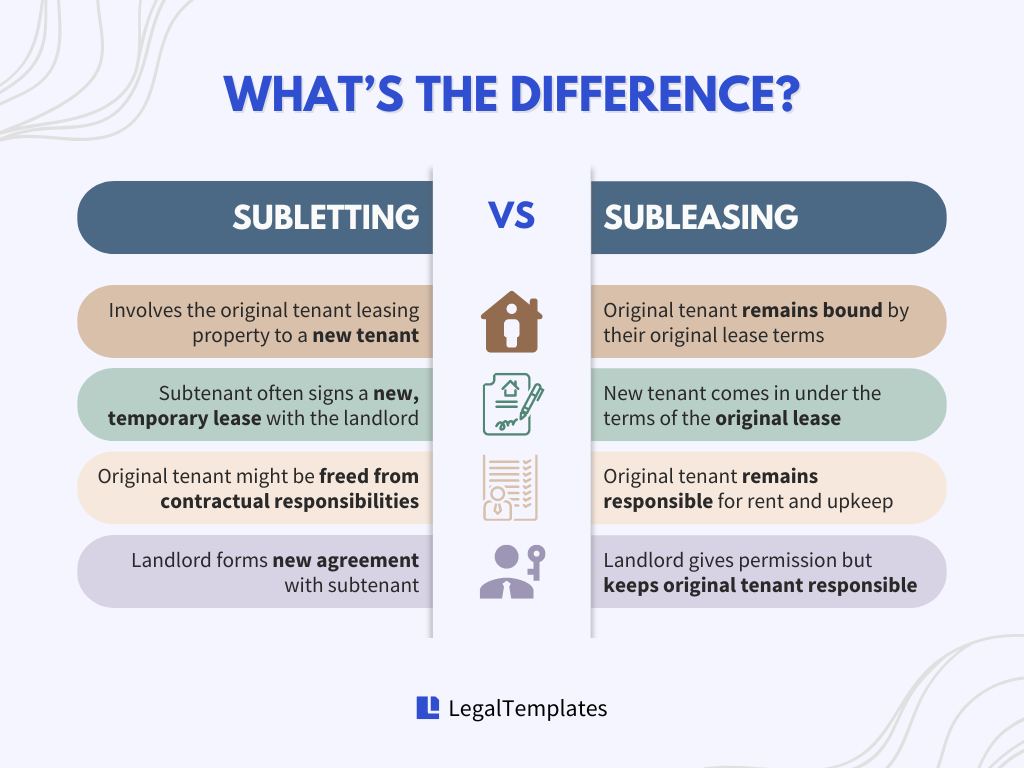
Subletting is a housing arrangement between a current tenant (sublessor) and a new occupant — the subtenant or sublessee. The sublessor rents part or all of their home to the subtenant for a set period through subleasing.
The sublessor can collect rent payments on a space or property they aren’t using by subleasing to another tenant. At the same time, the subtenant can secure a living arrangement that might otherwise be impossible.
Keep reading to learn more about how subleasing can solve your housing needs.
How to Sublease
Read our guide on how to sublease an apartment in four easy steps.
What Is Subletting?
Subletting means renting out your currently leased house or apartment to someone else.
Common among college students studying abroad, this approach helps cover rent for unused space. It offers a convenient solution for temporary absences, eliminating the need to terminate and later reinstate the original lease.
Subleasing vs. Subletting
While often used interchangeably, subleasing and subletting differ in how they connect landlords, tenants, and new occupants.
- Subleasing: The original tenant remains responsible for the lease terms while renting out their space.
- Subletting: Often involves the new tenant forming a new, temporary lease agreement directly with the landlord.
Understanding these differences can help you choose the right arrangement for your situation.

Reasons Behind Subletting
Subletting, where a tenant rents out their rented space to another person, is a common practice with various motivations behind it. Here are some of the key reasons:
Step 1 – Financial Relief
- Covering Rent: Tenants who need to move temporarily but are still responsible for their lease may sublet to cover the rent and avoid financial strain.
- Reducing Costs: Subletting can help tenants manage costs when they’re facing financial difficulties, providing a temporary solution to balance their budget.
Step 2 – Temporary Relocation
- Work Assignments: Professionals who are assigned to a different city or country for a short-term project or job may sublet their apartment to maintain their lease and avoid paying for two residences.
- Education: Students or individuals on sabbaticals who need to move for educational purposes often sublet their apartments.
Step 3 – Vacant Property
Travel or Personal Reasons: Tenants who are going on vacation, sabbatical, or a prolonged personal trip might sublet their place to ensure it is occupied and to help cover the costs of maintaining the lease.
Step 4 – Lease Obligations
Lease Requirements: Some lease agreements have clauses that allow subletting under specific conditions, making it a viable option for tenants who need to move out temporarily but want to fulfill their lease obligations.
Step 5 – Avoiding Lease Termination
Maintaining Tenancy: Subletting allows tenants to maintain their lease rather than terminating it early, which can be beneficial if they wish to return to the same property in the future.
Step 6 – Testing Living Arrangements
Trial Periods: Sometimes people use subletting as a way to test out a living arrangement or a new neighborhood without committing long-term.
Step 7 – Legal and Contractual Reasons
Mitigating Risks: Subletting might be a strategic decision to avoid breaking a lease or to adhere to specific terms in a rental agreement.
Step 8 – Helping Friends or Family
Personal Circumstances: Subletting to friends or family can be a way to offer them accommodation while ensuring the space is occupied by someone reliable.
Key Steps for Subletting
Before you sublease, the first thing is to find out if you can sublease. Here are the main areas to check:
1. Lease Agreement Permissions
Subletting Clause: Most leases include a subletting clause that outlines the conditions under which subletting is permitted. It’s crucial to review this clause to understand any restrictions or requirements.
Restrictions: Some leases may prohibit subletting altogether or require written consent from the landlord before proceeding.
2. Obtain Landlord Permission
Your rental agreement may require your landlord’s consent before you can sublease or prohibit subleasing altogether.
In either case, subleasing without complying with the lease terms may give your landlord the right to terminate your lease.
Can a Landlord Reject a Subtenant?
Yes, while a landlord can reject a subtenant, the decision must be based on reasonable and non-discriminatory criteria, and it should comply with the terms of the lease agreement and applicable laws. Tenants should be aware of their lease terms and legal protections when dealing with sublease requests. [1]
3. Pick a Suitable Subtenant
- Background Check: Conducting a thorough background check on potential subtenants is crucial. This may include checking credit history, rental history, and employment status.
- References: Ask for and review references from previous landlords or employers to gauge the subtenant’s reliability and suitability.
4. Research State and Local Laws
State and local laws govern rental practices. So, always check the provisions of your state and local landlord-tenant laws.
For example, in New York City, you can rent out your apartment even if the landlord refuses to consent in case their refusal to give permission is unreasonable.
Example of a Successful Sublease
A tenant, who has been working in New York City for the past two years, needs to relocate to San Francisco for a temporary project assignment lasting six months. The tenant has an apartment in Manhattan but does not want to end the lease or leave the apartment vacant during this period.
Here’s what they did to sublet their apartment successfully:
Step 1 – Review Lease Terms
The tenant reviews the lease agreement and finds that it permits subleasing with the landlord’s approval. The tenant contacts the landlord to request permission to sublease the apartment. The landlord agrees to the sublease as long as the tenant finds a responsible subtenant and follows the stipulated procedures.
Step 2 – Find a Subtenant
The tenant posts an ad on a reputable rental platform and also contacts their network for recommendations. They screen potential subtenants carefully, considering factors such as rental history, financial stability, and references.
Step 3 – Choose a Subtenant
After several interviews and reference checks, the tenant selects a candidate who needs a temporary place to stay while completing an internship in New York. The candidate’s background check is clean, and they seem like a responsible subtenant.
Step 4 – Draft a Sublease Agreement
The tenant and the subtenant sign a sublease agreement that outlines:
- Term of Sublease: 6 months, from [Start Date] to [End Date].
- Rent Amount: $2,000 per month.
- Security Deposit: $1,000.
- Responsibilities: The subtenant agrees to maintain the apartment in good condition and pay rent on time. The tenant remains responsible for the original lease terms and ensures that the subtenant has a clear understanding of building rules and responsibilities.
Step 5 – Handover Process
The tenant provides the subtenant with keys, instructions for apartment maintenance, and contact information for the building manager. They conduct a walk-through of the apartment to document its condition, noting any existing issues.
Pros and Cons of Subletting
Subletting your apartment has advantages and disadvantages.
Pros of Subleasing
- Finances. You can sublease unused space in your apartment to split the costs and keep a handle on your finances, especially if money is tight, or get help paying for a space you’re not using.
- Flexibility. Subleasing your apartment allows you to move to a different city for a while or leave your rental for another reason, such as moving in with family to help aging parents.
- Contractual obligations. Subleasing is a good solution for many challenges that may otherwise cause you to break your lease, such as when you will be away for a while. A sublease agreement can help you cover your rent, so you don’t have to break your lease.
Cons of Subleasing
- Looking for a renter. Finding a qualified subtenant can be challenging (can the new tenant afford the rent? do they have a clean rental background?), so you may spend a lot of time, effort, and resources trying to find the right person.
- Your reputation is at stake. Subleasing to an irresponsible subtenant who may damage the rental property or not pay rent is problematic, especially if you want to move back into the rental at some point.
Tips for Subleasing
Subleasing offers many benefits, like the freedom to travel without losing money or breaking a lease. However, subleasing can also be a risky arrangement.
Use these tips to make your subleasing experience as stress-free as possible.
- Make sure you’re ready: If you’re the sublessor, ensure you are comfortable subleasing. Subleasing isn’t a passive arrangement; you must be prepared to address any potential problematic behavior with your subtenant.
- Understand the eviction process: You must be careful and understand the eviction process for removing a subtenant for non-payment or inappropriate behavior because you are still responsible and liable under the original lease agreement.
Renters' Insurance
If you’re subleasing long-term, it’s wise to update your renters’ insurance policy to reflect your new living arrangement. Additionally, it’s a smart move to require your subtenant to have their own renters’ insurance. This provides an extra layer of protection for their possessions and any potential liabilities.
Wrapping Up
Subleasing can be an effective solution for tenants needing to temporarily vacate their rental or co-op apartment while still managing their lease obligations. By understanding the key components of subleasing—such as the approval process, potential fees, and the differences between subleasing and subletting—you can navigate this arrangement more effectively.
Before proceeding, it’s crucial to review your lease or co-op policy, obtain necessary approvals, and consider any associated costs. Properly handling these aspects ensures a smooth transition for both you and your subtenant.
Whether you’re looking to sublease for financial relief, flexibility, or to manage a temporary absence, being well-informed and prepared can help you make the most of this housing arrangement while minimizing risks and complications.
Frequently Asked Questions
Can You Sublet a Co-op Apartment?
Subletting a co-op apartment typically requires approval from your co-op board. Here’s a quick guide to help you navigate the process:
- Check Your Co-op’s Policy: Review your co-op’s sublet policy to understand the rules and approval process. Most co-ops permit subletting but require board approval.
- Consider Fees: Before setting the rent, account for any co-op fees, including maintenance and potential sublet surcharges. Make sure the rent you charge covers these costs.
- Get Board Approval: Your prospective tenant must be approved by the co-op board before moving in. Ensure you follow all necessary steps to gain this approval.
What Is a Sublease Fee?
A sublease fee is a charge imposed by your landlord or co-op board for permitting you to sublease your apartment or co-op unit. This fee can be used to cover various costs associated with the sublease, such as background checks and application fees. Additionally, some renters may include a sublet fee in their sublease agreement to serve as a security deposit, protecting against potential damage during the sublease period.
Whether or not a landlord or co-op board can charge a sublet fee depends on state laws and the terms outlined in your lease agreement. In most states, landlords are permitted to charge a reasonable sublet fee if it is stipulated in the lease.
